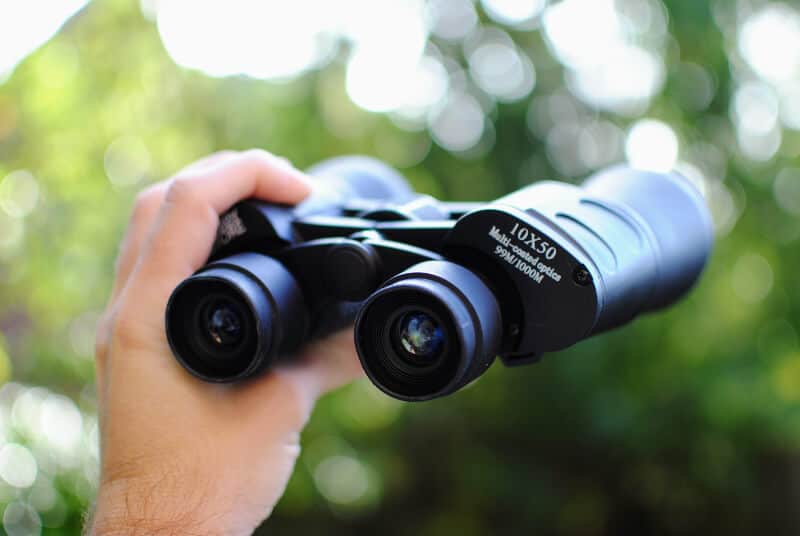“10×50” for binoculars means that they have 10x magnification and 50mm lens diameter.
These two are the most important specifications for binoculars and are almost always included in the model name.
But what does 10×50 mean for binoculars in terms of what you can see through them, what they are good for, and whether they are right for you?
We will cover this in the article. Let’s get started.
Understanding Terminology: What Does 10×50 Mean for Binoculars?
When you’re looking at binoculars, you’ll likely see that each model has something like ’10×50′ in the model name. For example:
- Celestron Outland X 10×50 Binocular
- Oberwerk 10×50 Ultra Binocular
- Nikon Aculon 10×50 Binocular
The ’10×50′ specification on binoculars is a standard way of conveying two critical pieces of information about the binoculars’ performance:
- The first number (10) refers to the magnification power
- The second number (50) refers to the diameter of the objective lens in millimeters
Both numbers in the ’10×50′ specification are crucial as they directly influence your viewing experience.

Magnification
Magnification of ’10x’ means that the binoculars can make an object appear ten times closer than it would to the naked eye.
For example, if you’re viewing a bird that’s 500 feet away through 10x binoculars it will appear as though it’s only 50 feet away.
Higher magnification enables you to view distant objects in greater detail, which can be particularly beneficial for activities such as bird watching, hunting, or astronomy.
It is not necessarily the case that higher is better for magnification though:
- Higher magnification also means a narrower field of view, which can make it harder to locate and track moving objects.
- Higher magnification can result in a shakier image, as small hand movements are magnified. This is why high-powered binoculars are best used with a tripod.
- Additionally, magnification also magnifies any unclarity. Therefore it is important that it is combined with high-quality lenses with bigger aperture. Higher magnification with small lenses won’t give you good views.

Objective Lens Diameter (Aperture)
The ’50’ in ’10×50′ refers to the diameter of the objective lens (the lens at the end of the binoculars furthest from your eyes when you’re using them). This is also known as the ‘aperture’.
A larger objective lens allows more light to enter the binoculars, which can provide a brighter and clearer image, especially in lower light conditions. This is particularly important for activities like stargazing or bird watching at dawn or dusk.
Therefore, binoculars with a larger objective lens size will provide better views.
However, there are also some disadvantages to consider with larger lenses:
- They make binoculars heavier and potentially less portable
- They make binoculars more expensive

Other Factors to Consider
Choosing the right binoculars involves more than just deciding on the magnification and objective lens size. Here are some other factors to consider:
- Field of View: This is the width of the area you can see through the binoculars. Higher magnification results in a narrower field of view. A wider field of view makes it easier to locate and track moving objects which can be important for certain binocular pursuits.
- Image Quality: This can be influenced by the quality of the lenses and prisms, the lens coatings, and the alignment of the optics. Higher-quality binoculars will provide sharper, brighter images with better contrast.
- Weight and Size: If you plan to carry your binoculars for extended periods, consider their weight and size. Larger, heavier binoculars can be tiring to hold and may require a tripod for steady viewing.
- Durability and Weather Resistance: If you’ll be using your binoculars outdoors, consider how well they will stand up to the elements. Many binoculars are waterproof and fog-proof for use in challenging conditions.
- Price: Finally, consider your budget. While higher-priced binoculars often offer better performance and durability, there are also many affordable models that offer good value for their cost.
Different factors will be more important depending on your intended use for the binoculars. For example:
- A hiker may prefer compact binoculars to keep their pack light
- A bird watcher might prefer binoculars with higher magnification for detailed views of distant birds but doesn’t need high aperture as they are viewing in daylight
- An astronomer will require binoculars with a large objective lens for maximum light gathering
- A sports fan might prefer a wider field of view to follow the action
When selecting binoculars, start by considering your primary use for them. If you’ll be using them for a variety of activities, consider which features are most important for each activity and try to find a balance that will serve you well in most situations.

What are 10×50 Binoculars Good For?
10×50 binoculars can be used for a variety of purposes:
- Bird watching: The 10x magnification allows for detailed views of birds at a distance, while the relatively wide field of view makes it easier to locate and track birds in flight. The 50mm lens provides bright, clear images even in the early morning or late evening when many birds are most active.
- Hunting: 10×50 binoculars can deliver detailed views in a variety of lighting conditions. The 10x magnification allows for detailed observation of animals, helping to identify species, gender, and age, while the 50mm objective lens performs well in the low-light conditions of dawn and dusk when many animals are most active.
- Astronomy: They can be used for stargazing to provide good views of the moon, stars, and larger celestial objects. However, they are not perfect for this – see more on this below.

Are 10×50 Binoculars Good For Astronomy?
10×50 binoculars can be used for astronomy, but they are not ideally suited for this purpose due to two reasons:
- The 10x magnification is right at the maximum for using binoculars by hand. Ideally, you want smaller than this if you scanning the sky by hand for things like meteor showers, or you want larger for more detailed views of planets and other objects.
- The 50mm aperture is slightly too small to provide you with meaningfully good views of night sky objects. I generally recommend 70mm as the minimum for binoculars or telescopes for astronomy.
Therefore you can go in two different directions for binoculars for astronomy:
- Low magnification for night sky observing by hand. Something like a pair of 7×50 binoculars will actually be better for this than 10×50.
- High magnification and high aperture for detailed observation of specific objects. For example, the 20×80 Celestron SkyMaster Binoculars.
10×50 binoculars can certainly be used for casual astronomy and if you already have a pair for other purposes you can definitely have a go at using them for stargazing. However, they would not be our recommended option if buying specifically for this purpose.
See the Best Astronomy Binoculars for more on this and our overview of the top models to buy.

What Can You See With 10×50 Binoculars for Astronomy?
With astronomy, it always depends on the levels of light pollution where you are.
Under completely dark skies free of light pollution you can view galaxies and the Milky Way core with your naked eyes. In cities with high light pollution you might be lucky to see a single star.
Therefore, there is no definitive answer to what you might be able to observe with 10×50 binoculars. They will improve your views but they will not perform magic.
Here’s a list of some things you can see:
- The Moon: The moon is a good target for 10×50 binoculars. You’ll be able to see more detail on the lunar surface, including larger craters, mountain ranges, and lunar seas.
- Planets: You can see the planets of our solar system, but the level of detail will be limited. In the right conditions, you’d be able to see Jupiter’s four largest moons as tiny points of light and observe the phases of Venus. Saturn will appear as a small oval due to its rings.
- Stars and Constellations: Binoculars can help you see stars that are not visible to the naked eye. This can help you identify more constellations and get a better understanding of the night sky.
- Star Clusters: Objects like the Pleiades and the Beehive Cluster are beautiful to look at with binoculars. You’ll be able to see that these “fuzzy spots” are actually composed of many stars.
- Nebulae: Larger and brighter nebulae like the Orion Nebula can be seen with 10×50 binoculars. You won’t see the color that appears in photographs, but you can see the glowing gas cloud.
- Galaxies: Under dark skies, you can see the Andromeda Galaxy as a faint smudge of light.
- Comets and Meteor Showers: During certain times of the year, you can observe these phenomena quite well with 10×50 binoculars.
- Milky Way: In a dark sky location, away from city lights, you can use binoculars to scan the Milky Way and see the myriad of stars it contains.

What are the Best 10×50 Binoculars?
There are a number of good 10×50 binoculars in the market with prices that can vary quite considerably. For example:
- The Oberwerk 10×50 Ultra Binocular cost nearly $300
- The Celestron Outland X 10×50 Binoculars and the Nikon Aculon 10×50 Binoculars cost both around $100
What benefits do you get for paying the extra money? Essentially it comes down to a few factors:
- Optical Quality: Binoculars with higher-quality lenses, prisms, and lens coatings can improve views by reducing reflection and increasing light transmission but will cost more.
- Build Quality: Some binoculars will be of better build quality, which can lead to improved durability and longevity. Some will be waterproof or weatherproof, which can be an important feature for outdoor use.
- Brand Reputation: Reputable brands like Oberwerk, Celestron, and Nikon provide a degree of reliability and customer support, instilling greater confidence when purchasing. This is certainly relevant if considering the sort of random brands that occur on Amazon – the equipment may be just as good as the known brand model (and may be from the same factory), but you won’t have the warranty or aftersales support.
FAQs: Binoculars 10×50 Meaning
What Does 10×50 Mean for Binoculars?
“10×50” for binoculars means that they have 10x magnification and 50mm lens diameter.
Which is more powerful 10×50 or 20×50 binoculars?

20×50 binoculars will have a higher magnification of 20x, compared to 10x for 10×50 binoculars, making them more “powerful” in that sense
They both have the same size 50mm lenses. Binocular views improve when lenses get bigger.
What is better 10×50 or 10×42 binoculars?
10×50 binoculars are better than 10×42 binoculars because they have larger lenses which enables them to capture more light and give better views.
The only advantages 10×42 binoculars might have would be that they would be smaller and lighter, and maybe cheaper.

Verdict: Are 10×50 Binoculars Any Good?
Overall, 10×50 binoculars are good for a number of purposes, particularly terrestrial pursuits like wildlife viewing.
They can be used for astronomy but they are not what we would recommend for this purpose. Better to either go for lower magnification for the wider field of view or higher aperture for more of a telescope-like experience.
Related articles:




Appreciate your simplistic approach to the amateur, I have a pair of binoculars that state that they are 90×90 and 105’ @ 1000 yards, this does not make sense to me as they don’t appear to be much different to the 10×50 294’ @ 1000 yards, can you please explain, and what would one use these for. Many thanks Bill Olsthoorn WAus
Hi Bill, not sure what 90×90 would refer to. It might just be a confusing model name like with these ones I found – https://www.amazon.com/Professional-Binoculars-Hunting-Telescope-Optical/dp/B09DPGKLR6. Hope that helps.
ARE PENTEX 10X50 BINOCULARS ARE OF GOOD QUALITY?
Yes!